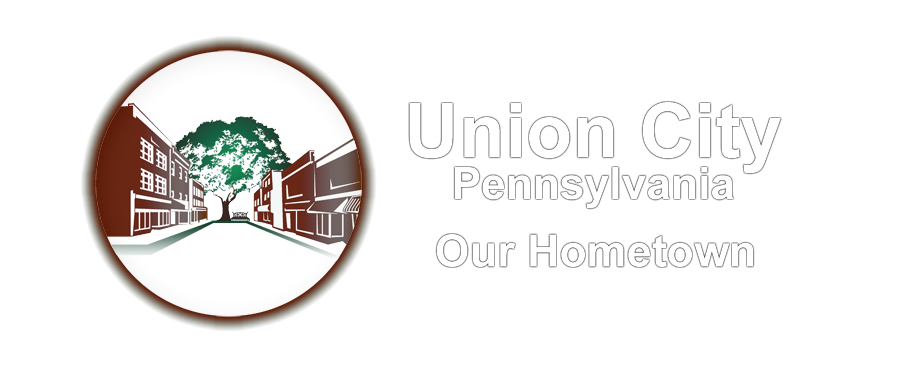
This mural commemorates the 150th anniversary of the naming of Union City in 1871 by paying tribute to the community’s rich cultural heritage and reflecting the town’s manufacturing, milling, agricultural, and recreational traditions, as well as its most celebrated natural resource – French Creek.
The community was engaged early in the design process to help identify key themes and colors. Artists Tom Ferraro and Steve Mik of the Looking Glass Art Project gathered input through surveys, stories, and interviews, all of which supported the understanding that Union City played a key role in the development of Erie County, Pennsylvania. Additional information was gathered from resources found in the Union City Museum and Historical Society and Erie County Public Library, online, and during visits to the community.
Located at the southern end of the Union City Business District, the mural’s design welcomes visitors entering the borough from the south. The artists chose to frame the composition with an archway, which reinforces the location as a gateway and welcomes visitors into the downtown district. The archway is made up of abstract shapes that symbolize some of the natural elements surrounding the community. The darker green and orange shapes represent the forests and agricultural community that surround the Borough. In the lower section of the mural, the composition rides on blue and light green shapes that flow across the bottom, representing the impact of both the fortunes and perils of French Creek on the town.
A collage of images of Union City citizens through the ages is at the center of the mural. It represents the community’s story through its people and provides a visual timeline that stretches from the late 19th century to the present. These individuals are not dignitaries or celebrities, but rather they represent ordinary people – the true treasure of the community. The images are all sepia toned, and they were found in the photographic collections of the Union City Museum and Historical Society and in print and digital publications.
Starting from the bottom left, two unidentified boys surround a heating stove representing Union City’s heritage of manufacturing and commerce. Above the boys stands two women and a football player taken from a Union City High School yearbook from 1924. The women and athlete symbolize Union City’s commitment to and value of education and nurturing a competitive spirit. To the right of the football player stands Postmaster Wright (c. 1910) and George Warden with his granddaughter Margret Gardner. Warden was a sousaphone player for the Coleman Band, a musical group that entertained the region for over 80 years. Next are Sarah Kendall and Sylvester Butler (in a bearskin coat c. 1912). In the lower right is a photograph of George “Bummy” Showers and his daughter Marie, who symbolize the resiliency of the individual people and community of Union City. Showers was injured in an industrial accident at the age of 14 that left him without both arms. He went on to lead a life that inspired the entire community. His story mirrors the determination of a community that has overcome fires, floods, and severe economic challenges. Sliding into the Union City logo is a color image of a young softball player – a shoutout to the community’s present and future and commitment to revitalization.
These images are anchored by a circular logo that is currently being used to represent Union City, and it acknowledges the organization behind the mural project, Union City Pride. Pride is a community organization dedicated to restoring pride in and celebrating the heritage of the Union City.
Images with historical significance flank the central figures. The old fire truck on the left is now completely restored and housed across the street at the museum. The Union City train station depicted on the right is an example of preserving history through the reuse of historic buildings. Images of French Creek, the iron rail bridge, fall foliage, blue skies, and the rail line fill the background.
On the far right, the mural is completed by a standing figure of a railroad signalman, c. 1910. His green light welcomes visitors to Union City’s downtown. The signalman is leaning on a wooden chair, which acknowledges Union City’s chair making industry and informal title, “The Chair Center of the World.”
Installation of the 28 South Main Street mural supports the recommendations of the Union City Historic Preservation & Streetscape Plan. The gateway mural welcomes the more than 8,000 vehicles that travel through Union City daily and highlights the historical significance and vitality of the downtown district.
Funding for the project was provided in part by the Erie County Gaming Revenue Authority, Erie Community Foundation and in part from an Erie Arts & Culture Project Grant made possible by community contributions to the United Arts Fund and the Erie Arts Endowment.
